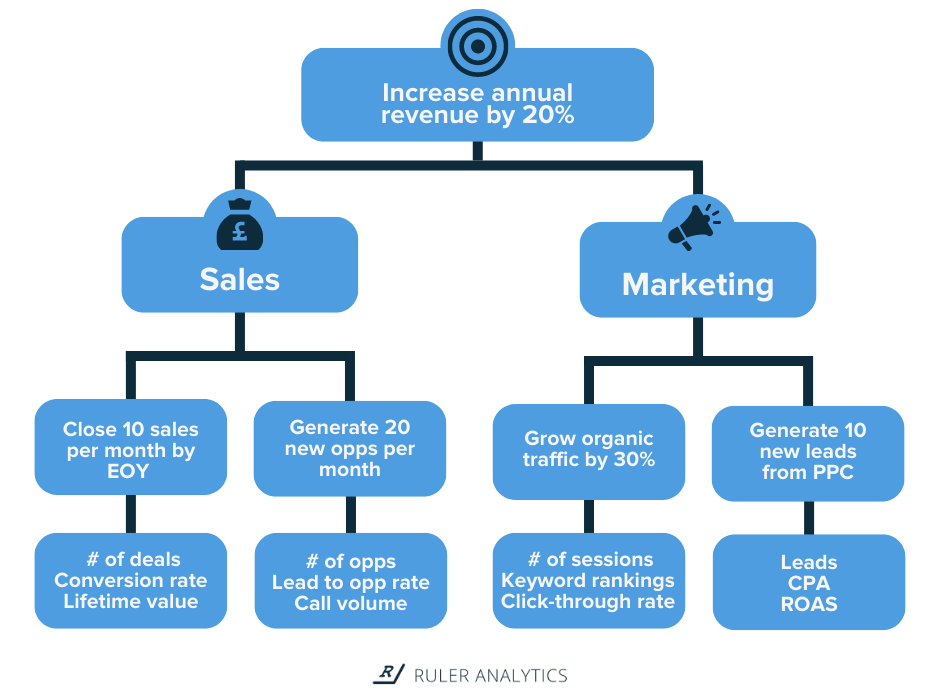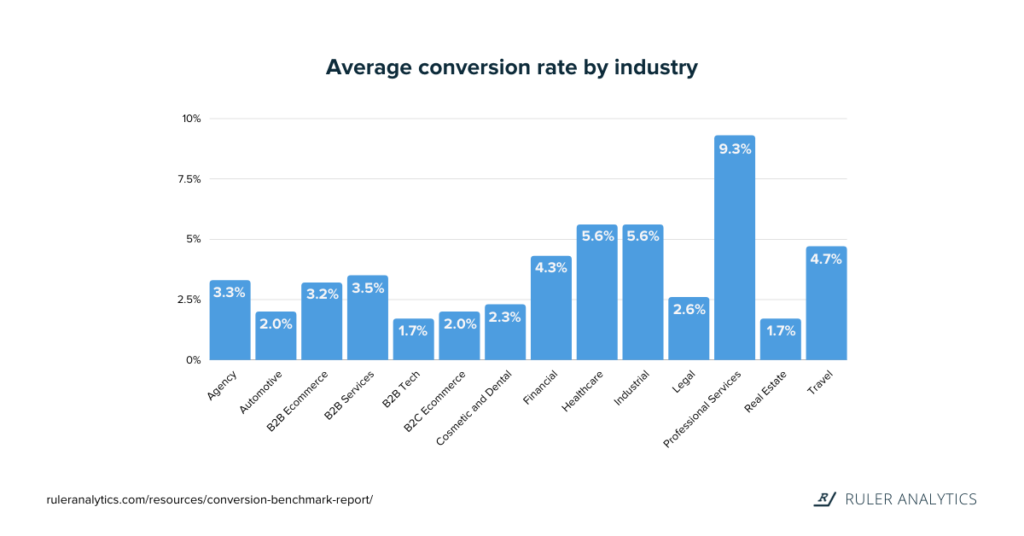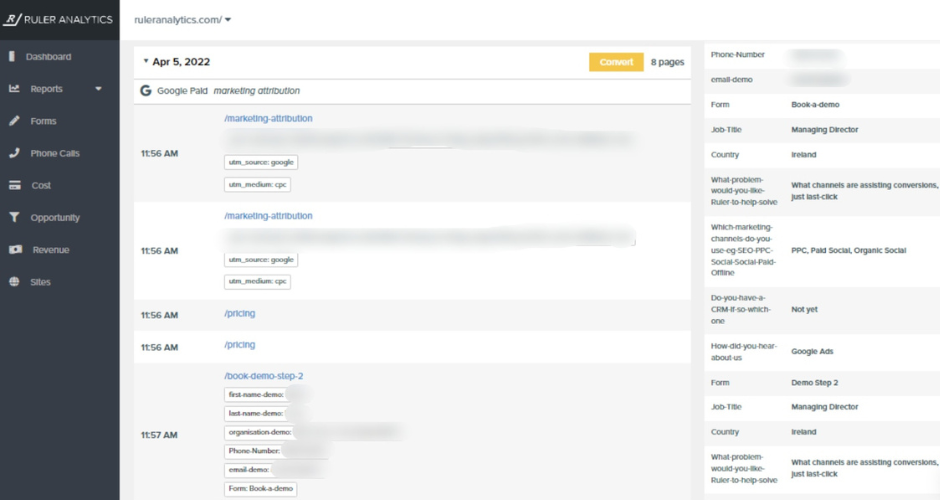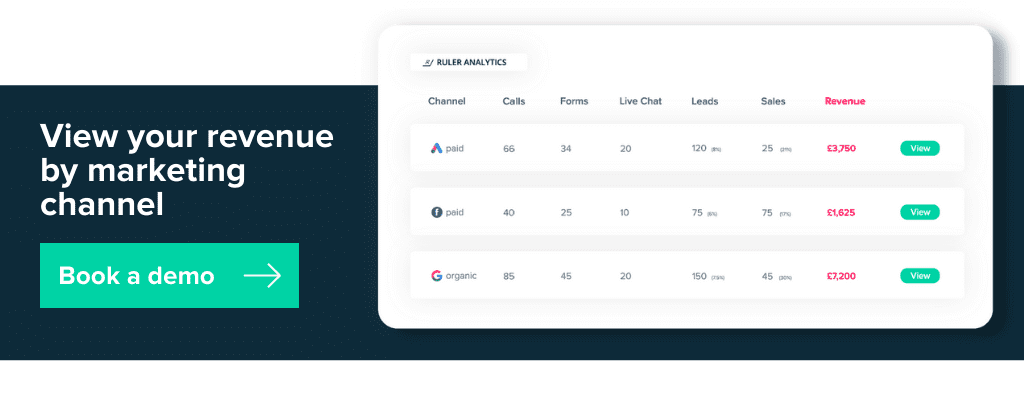We take a deep dive into marketing KPIs and show you how to choose the right ones to measure the progress of your marketing.
Marketers need to know how to measure what’s working. It’s non-negotiable.
If you can’t measure your marketing, how do you know it’s working for your business?
You don’t.
To track marketing effectiveness, marketers will depend on KPIs.
But ask a room full of marketers what KPIs they use to measure marketing success, and you’ll receive a variety of responses.
That’s because there are a ton of KPIs to choose from.
As a provider of attribution and analytics, we know a thing or two about measuring marketing effectiveness.
So we decided to put together this guide with a breakdown of the best marketing KPIs to help maximise your efforts.
In this article, we’ll discuss:
💡 Pro Tip
Ruler Analytics can help make your marketing reporting easier. We provide marketers with the data they need to connect their marketing activities to closed revenue and help them track important metrics like ROI, ROAS and CPA.
Learn more on how to measure your marketing with Ruler
Table of Contents
A KPI (key performance indicator) is a measurable component that evaluates the effectiveness of your marketing. They help you understand whether you’re putting your marketing efforts in the right place to drive profitable results.
Related: How to measure your marketing performance
There are many benefits of establishing and using KPIs in marketing. KPIs allow you to:
Tracking key performance indicators will help you make informed decisions about your marketing strategies and budgets. But what does a good KPI look like? The answer relies on your business and its objectives. You can use the following criteria to whittle down your options.
To pick marketing KPIs that matter, you first need to understand what it is your company is trying to achieve.
Is it to sell more merchandise? Generate leads? Drive subscriptions? Once you have answered this question, you can start to select goals and marketing KPIs that match your company’s overall objective.
For example, let’s say your company sets an objective to increase annual revenue by 20%.
Each department, including yours, would need to set its own unique goals to help reach this objective.
Once these goals are agreed upon, you’re ready to assign KPIs to help monitor your progress.
Take the image below, for example.

In this scenario, we can see that the marketing team has decided to focus on PPC search to attract more leads and help reach the desired goal.
They’ve chosen the following metrics to monitor progress and stay on track:
With these KPIs, the marketing team can keep a finger on the pulse of their paid ads. They can track progress and measure how well their efforts impact company objectives.
“Profitability is what ultimately matters, and it is surprising how many marketing reports we see that do not refer to this,” says Andy Hunt, Strategy Director at WeInfluence.

More and more marketers are being held accountable for revenue.
Our data backs it up. We found that 55% of marketers are responsible for increasing revenue.
We can’t say that we’re surprised. Historically, marketers would lean on metrics like traffic, clicks and leads to highlight the value of their contributions.
While increased traffic, brand awareness, and engagement are all wonderful benefits of marketing, they don’t highlight how marketing activities drive revenue.
We all know it’s revenue that keeps the lights on, right?
John Warner, Senior SEO, Content & Marketing at Click Consult, agrees: “While there are plenty of metrics you could offer as integral to a digital marketing report – from sessions through to conversion rate – there’s one area that gets neglected. That’s revenue impact.”
Your clients or executives want to know where their money is being spent and what they’re getting in return. And they deserve to know.
So you must show them how your marketing efforts are paying off through KPIs that highlight your impact on revenue.
Related: 6 Revenue metrics you should be measuring
We know it’s not always possible to track revenue KPIs, and that’s ok. But if you can prove how marketing impacts revenue, you’re guaranteed to gain the trust of your client or executives.
There’s no general ‘rule of thumb’ on how many marketing KPIs you should measure.
The answer depends on your business and how many channels you decide to use.
Robert Stoubos, Founder of Odyssey New Media, agrees: “Some campaigns require only reporting on certain metrics, while others are multi-channel and require many more metrics to gauge cross-channel performance.”

Our advice is to keep it simple. Dan Pilay, Head of CampaignHero, agrees: “Less is usually more.”
If you track too many marketing KPIs at once, you risk spending too much time on the reporting and not enough time on the work.
Think about it this way.
If you have more KPIs than you need, then they’re not necessarily “key”.
They’re just performance indicators.
“We simplify all our marketing metrics (across all channels) down to the most relevant three,” says Phil MacKechnie, Digital Marketing Expert at Radfield Home Care.

Phil added: “This way, we can recognise our common goals and drivers in terms of what each channel contributes. Each channel can, of course, have additional secondary metrics. But, by having three in common, we can understand our common goals regardless of what channels we’re responsible for.”
Marketing is all about measuring and tracking results.
While you can use many marketing KPIs to track the success of your campaigns, there are only a select few that should be most important for your business. Here’s a rundown of what they are:
“Lead generation is always an important aspect to include. Ensure that your client understands the criteria behind a lead, and the stages they go through, from lead nurture right through to acquisition,” says Amy Wilkinson, Director of Disruptive Thinking.

A lead is someone who has shown interest in your product or service.
They may express their interest by filling out a form, making a phone call or submitting a query on live chat.
When measuring success in marketing, companies will often look at the number of leads.
And while this metric offers some value, measuring leads only takes you so far.
Leads don’t guarantee revenue.
Just because your campaign is generating a ton of leads doesn’t mean it’s profitable.
Don’t get us wrong. We’re not saying you shouldn’t track leads. Tracking leads allows you to get a quick snapshot of the performance of your marketing campaigns.
“Without conversions, businesses wouldn’t make money,” added Matt Cocking, Head of PPC at Anicca Digital.
Related: What is lead tracking and tips on how to get started
You should make some reference to the number of leads you’ve generated in your marketing reports.
For example, Charlotte Fallon, Account Manager at Embryo Digital, told us that their reports “are centred around the number of conversions. Calls, form enquiries, purchases, downloads, any actions taken on our client’s website which impacts their business.”

But what you shouldn’t do is use lead quantity as a sole factor to guide important marketing and budgetary decisions.
💡 Pro Tip
Are you struggling to prove where your leads are coming from? Ruler can help. It tracks data on a visitor level, allowing you to successfully attribute CRM leads and revenue back to your campaigns, ads, keywords, landing pages and more.
How to track where your leads come from with Ruler
Cost per lead is the go-to metric for advertisers.
To calculate cost per lead, you take the total cost of traffic generated to your website and divide it by the total number of leads, and you’re good to go.
At first glance, cost per lead seems like the obvious metric to keep costs in check.
But like lead volume, CPL isn’t a reliable metric to track your progress on wider company objectives.
Related: Cost per lead: Is your marketing effective?
We’ve already discussed that a lead doesn’t equal a sale. So just because you’re generating more leads at a lower cost doesn’t automatically mean you’re making a profit.
To really understand the value of your ad campaigns, you need to look beyond leads and focus on revenue metrics (we’ll get to these shortly).
Lead source allows you to track where your leads and opportunities are coming from and what channels they used to find you. It’s essentially the first marketing touchpoint in your customer journey.
Related: What is lead source (+ tips from 30+ experts)
For example, a user could enter a search term into Google, click an Ad and buy a product. In this case, paid search would be your lead source.
Tracking lead source is essential as it allows you to measure, plan and optimise your marketing efforts to generate more solid results for your business.
Alexandra Ingram, Director of Paid Media at Trafiki eCommerce Marketing, told us that they recently “decided to include site-wide and multi-channel attribution sales and revenue data to measure the brand halo effect across other traffic sources.”
💡 Pro Tip
Using a tool like Ruler you can seamlessly track the source of your leads and sales in your CRM, without having to do any manual work.
How to send lead source to your CRM
“Most of our clients are interested in cost per conversion and conversion rate,” says Roy Dovaston, Managing Director at Click Guardian.
Calculating your conversion rate is relatively straightforward. All you do is take the number of conversions and divide it by the number of total clicks or visits, and that’s it.
For example, if your latest PPC campaign had 1,000 clicks and 30 sales, your conversion rate would be 3%.
At this point, you’re probably wondering what a good conversion rate looks like for your company. When it comes to conversion rate, there’s no one-size-fits-all approach. Conversion rates vary by industry, marketing source, average sales length and more.
However, we did run a study into Ruler’s global database, which has over 100 million data points to distinguish the average conversion, call and form rate across fourteen industries.
You can find more stats and insights into each specific marketing source in the full blog (average conversion rate by industry and marketing source), but here’s a quick look at the average conversion rate by industry.

As you can see, conversion rate varies across all industries. One thing is clear, though. The higher the price, the lower the conversion rate. Makes sense, right? It’s much harder to sell a house than it is to flog a pair of shoes in the sale.
Lead to opportunity rate is what it says on the tin. It’s the percentage of leads that convert to opportunities.
To calculate your lead-to-opportunity conversion rate, just divide the number of leads converted to opportunities by the total number of leads.
For example, let’s say you had 1000 leads and 200 of these leads converted to opportunities. Your lead conversion rate would be 20%.
Lead to opportunity rate is used to measure the productivity of your sales and marketing teams. A high lead-to-opportunity rate is something to be celebrated. It means whatever you’re doing to attract and convert leads is working.
If your lead-to-opportunity rate is low, there’s clearly something wrong. Either marketing is driving the wrong type of leads, or sales aren’t doing their part to convert leads properly.
You can think of cost per acquisition as the shinier version of cost per lead.
Cost per acquisition (CPA) is similar to cost per lead, but this metric applies to leads who have converted into a deal or customer.
In other words, cost per acquisition shows how much it costs to get a single customer down your sales funnel, from the first touch point to the ultimate conversion.
To calculate cost per acquisition, you divide the total costs of all acquisitions by the number of new customers in a certain timeframe.
Related: 5 easy ways to reduce your customer acquisition costs
Cost per acquisition is one of the most important marketing KPIs metrics you can track. It helps you focus on the channels and campaigns most likely to produce higher converting customers and ensure a steady stream of revenue.
“Our agency has a strong focus on ROI. We always try to put a value on each conversion, even if it’s a lead generation campaign. Ultimately, the client needs to be able to see a return,” says Cristiano Winckler, Head of Performance at Somebody Digital Ltd.

Return on investment is the practice of attributing profit and revenue growth to the impact of your marketing efforts.
Related: How to measure digital marketing ROI: 6 metrics you need to track
It’s no secret that tracking ROI is critical to your marketing success.
ROI validates whether or not your marketing efforts are working and helps justify budget allocation for ongoing and future campaigns.
But tracking ROI isn’t straightforward, especially if you have several channels working together to drive leads and customers.
In fact, we found that just over half of marketers are confidently tracking marketing ROI.
So what can you do to track ROI?
Related: How to definitively prove your ROI: Advice from experts
Our best advice is to invest in the right tools.
Take Ruler Analytics, for example.
Ruler is a marketing attribution tool that works by tracking your users across multiple sessions, traffic sources, advertisements, keywords, and more.
Let’s look at the image below. In this specific journey, we can see that this lead searched for “marketing attribution” in Google. They landed on our marketing attribution product page and converted into a lead using a book a demo form.

Related: How to view full customer journeys with Ruler
When a visitor becomes a lead, their conversion data is combined with their marketing touchpoints to create a customer journey.
Ruler sends this information to your CRM and enriches your leads with marketing source data.

Once a lead converts into a deal, the revenue is passed back to your marketing channels, allowing you to track the effectiveness of your marketing efforts and accurately calculate your cost per acquisition and ROI.
“Thanks to the help of Ruler Analytics, our customers can listen back to every call and read every email to assign an exact job value. We know the amount of work booked in, so this allows the report to calculate an exact ROI,” says Daisy Foster, CEO at Digitool.
💡 Pro Tip
Ruler’s revenue attribution plays a key role in helping marketers make wiser budgetary investments. Learn more about the benefits of Ruler and how it can help pinpoint your most valuable marketing channels.
How Ruler attributes revenue back to your marketing
On the surface, ROAS and ROI sound the same, but they’re actually different.
Unlike ROI, return on ad spends measures revenue resulting from money spent on digital advertising.
Related: What is ROAS? Understanding ROAS in marketing
Many advertisers prefer ROAS to ROI as it focuses on the return of a particular campaign or ad. ROI, on the other hand, simply gives you an overall view and includes installation and maintenance fees.
“We recommend a ROAS (return-on-ad-spend) driven approach as it enables us to focus on what is working well, alongside seeing what isn’t,” says Aaron Crewe, Managing Director at Novi.Digital.

Despite their differences, ROAS and ROI are equally important and should be utilised to track the success of your ad campaigns.
Customer lifetime value is too important for any organisation to ignore.
It’s so valuable that 59% of SaaS marketers consider customer lifetime value a primary metric to demonstrate marketing success.
To calculate lifetime value, all you need to do is multiple the value of a customer by their average lifespan.
For example, say you have a SaaS product and onboard a customer for £500 per month.
They stay with you for 12 months before cancelling their subscription. The lifetime value for this customer would be £6,000.
Lifetime value has a lot to offer marketers, as they can use it to track which marketing efforts are converting the most loyal and profitable customers.
There you have it, our list of the top marketing KPIs.
If you’re not tracking at least some of these KPIs, you could be missing out on valuable insights into what’s working (and what’s not) in your marketing efforts.
Don’t forget. Ruler makes it possible to measure all these KPIs—plus many more.
With Ruler, you can generate deeper and more valuable insights into your marketing performance and make more data-backed decisions on where to invest your budget.
See how Ruler can help track your marketing performance. Or book a demo and see how Ruler can enrich your marketing reports with better quality data and insights.
